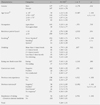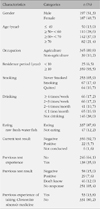Abstract
Purpose
The goal of this study was to analyze the prevalence of Clonorchis sinensis infection in people living within 5 km of the Youngsan River basin, to develop an educational program to prevent the infection, and to examine the effects of the educational program.
Methods
This study employed a one group pretest-posttest design, the subjects were 384. This study was conducted from November 20, 2008 to June 16, 2009. The results were analyzed with the SPSS/WIN 18.0 program.
Results
Of the residents, 5.7% were infected with Clonorchis sinensis and the knowledge level about the prevention of Clonorchis sinensis was improved significantly from 9.75±5.12 points before the education to 15.05±2.43 points after the education. One of the important effects was that the willingness to eat raw fresh-water fish was reduced after the education.
Figures and Tables
Table 3
Difference in Knowledge Level before and after Prevention Education according to Characteristics of Participants (N=384)

References
1. Cho SH, Lee KY, Lee BC, Cho PY, Cheun HI, Hong ST, et al. Prevalence of clonorchiasis in southern endemic areas of Korea in 2006. Korean J Parasitol. 2008; 46(3):133–137.

2. Choi SK, Park YH. A clinical review on biliary Clornorchiasis. Korean J Gastroenterol. 1986; 18:503–510.
3. Hwang CW, Lim BW, Ryu U, Kim JH, Park HY, Park KI, et al. A case of clonorchiasis presenting as common hepatic duct mass. Korean J Gastrointest Endosc. 2005; 31:268–272.
4. Ju YH, Oh JK, Kong HJ, Sohn WM, Kim JI, Jung KY, et al. Epidemiologic study of clonorchis sinensis infestation in a rural area of Kyoungnam-do, South Korea. J Prev Med Public Health. 2005; 38(4):425–430.
5. June KJ, So AY, Kim CM, Kim SY, Song YL, Jung HY, et al. Survey and control program development of clonorchiasis for high risk population at 5 major river in Korea. Seoul: Korea Centers for Disease Control and Prevention;2009.
6. Kim JH. Prevalence of clonorchiasis and its related factors among the inhabitants in Soonchang-gun, Korea. Iksan: Wonkwangl University;2009. Unpublished doctoral dissertation.
7. Kim KH, Jang BI, Tae NK. Clinical features of Clonorchiasis. Yeungnam Univ J Med. 2006; 23(2):171–181.

8. Kim SY, Kim CM, Choi HK, Kim YL, Park YA, Heo S, et al. Prevalence od clonorchiasis and related factors for inhabitants near the Sumjin river. J Korean Acad Rural Health Nurs. 2009; 4(2):79–86.
9. Kim SI, Yun WS. Control of human clonorchiasis at Gokseong-gun and Sunchang-gun near the Sumjin river in Korea. Korean J Rural Med. 2004; 29(1):163–175.
10. Kim HG, June KJ, Kim SY, Park MS, Kim CM. Clonorchis sinensis infection experience in residents living in riverside areas. J Korean Acad Community Health Nurs. 2010; 21(1):110–117.

11. Kong ES, Park HK, Yang KH, Oh MS, Lee WY, Lee JR, et al. Integrated health education. Seoul: Hunminsa;2007.
12. Korea Centers for Disease Control and Prevention. Recent prevalence of clonorchiasis in some regions of Korea. 2009. Retrieved March 25, 2010. from http://www.cdc.go.kr/kcdchome/jsp/home/information/had/INFOHAD0001Detail.jsp?menuid=100053&appid=kcdchome&content=/contents/information/had/b/9059_view.html.
13. Lee GS. Prevalence of clonorchiasis and related factors among the inhabitants in Okcheon-gun, Korea. Daejeon: Chungnam National University;2008. Unpublished doctoral dissertation.
14. Lee HK. Evaluation of sonography and skin test in diagnosis of clonorchiasis at the Hyonsan-gang(river) area. Korean J Parasitol. 1995; 33(2):117–123.
15. Lee GS, Cho IS, Lee YH, Noh HJ, Shin DW, Lee SG, et al. Epidemiological study of clonorchiasis and metagonimiasis along the Geum-gang (river) in Okcheon-gun (county) Korea. Korean J Parasitol. 2002; 40:9–16.

16. Lim MK, Ju YH, Franceschi S, Oh JK, Kong HJ, Hwang SS, et al. Clonorchis sinensis infection and increasing risk of cholangiocarcinoma in the republic of Korea. Am J Trop Med Hyg. 2006; 75:93–96.

17. Lee DH, Kim JH, Han BH, Lee SO, Shin HR, Jung IC. Geographical variation of liver cancer mortality in Korea. Cancer Res Treat. 2001; 33(5):420–426.
18. Park DS. Current status of clonorchis sinensis infestation and its related factors among the residence of rural communities. J Korean Acad Rural Health Nurs. 2007; 2(1):33–42.
19. Park MD. A study on the effects of clonorchis sinensis control intervention at a Sumjin riverside area (1999~ 2004). Gwangju: Chonman National University;2006. Unpublished master's thesis.
21. Sohn HK. Study on the spatial analysis of clonorchis infection in Korea. Seoul: Ewha Womans University;1985. Unpublished master's thesis.
22. Song IW. An epidemiological study on clonorchial infection of the inhabitants living in some regions adjacent to Daecheongho (lake). Daejeon: Chungnam National University;2007. Unpublished master's thesis.
23. Song YY, Park KS, Kwon YS, Kim NH, So YS, Lee MS, et al. Knowledge and prevalence status of Clonorchiasis for Inhabitants in the Nakdong riverside area. J Korean Acad Rural Health Nurs. 2009; 4(2):87–93.
24. The Korean Statistical Society. Prevalence of intestinal parasitic infection in Korea-The 7th report statistical analysis research. 2005. Retrieved March 25, 2010. from http://www.nanet.go.kr/03_dlib/01_datasearch/datasearch.jsp.
25. Yang KM, Park DS. Effects of educational program for clonorchis sinensis infection among rural communities in Korea. Nurs Sci. 2009; 21(2):12–21.




 PDF
PDF ePub
ePub Citation
Citation Print
Print






 XML Download
XML Download